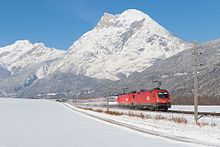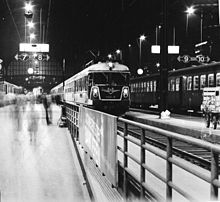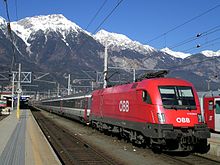Transalpine (train)

The Transalpin is a EuroCity long-distance train ( train number EC 163/164 ) that has been connecting Zurich with Graz every day since December 15, 2013 . From 1958 to 2009 a train ran under the same name from Basel (until December 2009) and from December 2009 to 2010 from Zurich to Vienna .
Surname
On the one hand, the name Transalpin can be derived from the term "transalpine", on the other hand from the Roman name of Switzerland as "beyond the Alps ".
Train run
The train takes 9 h 34 min from Zurich to Graz (opposite direction 9 h 35 min) and stops in Sargans , Buchs SG , Feldkirch , Bludenz , St. Anton am Arlberg , Landeck-Zams , Ötztal , Innsbruck , Jenbach , Wörgl , Kirchberg in Tyrol , Kitzbühel , St. Johann in Tirol , Saalfelden , Zell am See , Schwarzach-St. Veit , St. Johann im Pongau , Bischofshofen , Radstadt , Schladming , Stainach -Irdning, Liezen , Selzthal , St. Michael in Upper Styria and Leoben . In Buchs SG ( border station ) and Selzthal, the direction of travel is changed.
Train composition
The EC Transalpin consists in the schedule period 2016/2017 from a panoramic carriages of the SBB and otherwise from the cart ÖBB , including a dining car , and a half-luggage trolley with seats first class to which the bicycles possible. In the second class, both compartment cars and open seating cars are offered.
Between Zurich and Buchs, the Transalpin is pulled by an SBB Re 4/4 II , between Buchs and Innsbruck by two ÖBB 1016 or 1116 and from Innsbruck to Selzthal and after a change of direction to Graz by an ÖBB 1016 or 1116.
history

From June 1, 1958 to June 13, 2010, the Transalpin ran as a parade train of the SBB and the ÖBB between Basel and Zurich and Vienna. In the course of its history, the Transalpin had different train numbers: multiple units express train TS 11/12 , TS 462/463 , express train Ex 462/463 , EuroCity EC 62/63 and ÖBB-EC 162/163 . Until the 2000s it was always one of the fastest rail connections with the fewest stations in its relation. Between 1959 and the timetable change on December 12, 2009, he connected Basel SBB with Vienna Westbahnhof , in 1958 and from December 2009 until it was closed only Zurich main station with Vienna. It was replaced by a Railjet connection on June 14, 2010 .
At the beginning, the connection between Vienna and Basel was provided by four multiple units of the ÖBB series 4130 as vehicles , which were procured specifically for this purpose. These emerged from the 4030 series , but had higher performance and top speed. The control car was also equipped with a kitchen. To save time and to train not to have contact, the train did not stop in Salzburg main station , but was on the bow of Elixhausen by Salzburg- Gnigl out and held in Salzburg Aigen . Today this loop is mainly used by freight trains. In 1965, the ÖBB procured three six-part railcar sets of the series ÖBB 4010 for this long-distance train .
In 1969 the route was changed. Since then, the train has been running from the Westbahn via Salzburg Hauptbahnhof to Wörgl Hauptbahnhof on the German routes Rosenheim – Salzburg and Rosenheim – Kufstein of the Deutsche Bundesbahn (later: Deutsche Bahn AG ), instead of the previous one via Bischofshofen and Zell am See ( Giselabahn ). Since the Transalpin did not have a scheduled stop in Germany , it was run as a corridor train , which meant that the passport and customs controls that were otherwise necessary in the period before the Schengen Agreement could be dispensed with. Until the " Rosenheim Loop " was built in 1982, the train had to be turned around at Rosenheim station . Since 1977 the Transalpin has been running as a carriage train with a locomotive . In the first class one is since the 1990s panorama coaches of SBB carried.
The train route in the 2009/2010 timetable was: Wien Westbf - Wien Hütteldorf (only ÖBB EC 163) - St. Pölten Hbf - Linz Hbf - Salzburg Hbf - Innsbruck Hbf - Landeck-Zams - Bludenz - Feldkirch - Buchs SG - Sargans - Zurich HB .
The train changed direction in Buchs SG . The 1st class wagons ran in the ÖBB-EC 162 from Buchs to Zurich, in the ÖBB-EC 163 from Buchs to Vienna at the Zugspitze, so that at the two start and end stations, which are both terminal stations , they always follow the cross platform at next came to stand.
On the ramps of the Arlbergbahn , the train was often given a leader or sliding locomotive . If the Arlbergbahn was interrupted by construction work or due to natural events - such as avalanches and mudslides, or most recently from August to December 2005 after storm damage - the Transalpin from Salzburg was redirected over a wide area via Munich Hbf and the Bavarian Allgäubahn to Bregenz . From June 13, 2010, the Transalpin was replaced by Railjet 162/163 - in the same timetable - but which no longer bears the name Transalpin. In the 2014/2015 timetable there are five Railjet train pairs between Zurich and Vienna, and the EC train pair 163/164 Zurich – Graz – Zurich, which bears the name “Transalpin”, was introduced.
literature
- Siegfried Bufe: Salzburg - Bavaria - Tyrol . In: Eisenbahngeschichte 36 (2009), p. 44.
- Josef Mauerer: Changes to the ÖBB traffic over the Rosenheim loop . In: Eisenbahn-Revue 12/2009, pp. 628f.
- The "Transalpin" is history . In: Eisenbahn-Revue 8–9 / 2010, p. 413.
Web links
Individual evidence
- ↑ Timetable 2014 Austria (PDF; 5.9 MB) on oebb.at ( Memento from December 3, 2013 in the Internet Archive )
- ^ The changes to the timetable change in December 2013 and June 2014
- ↑ Seen from Rome; in contrast to Cisalpin , the region of today's Lombardy .
- ↑ Train composition EC 163 on vagonweb.cz
- ↑ a b The end of the Transalpin message on Der Standard from January 11, 2010
- ↑ Bufe, p. 44

